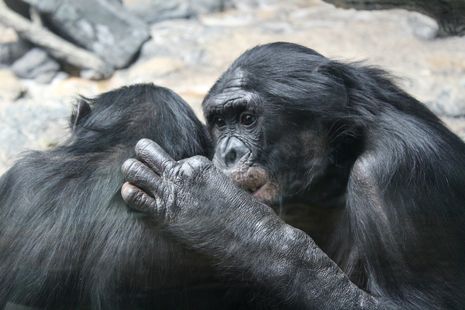Talking gorillas: The origins of language
Rory Cockshaw reflects on the nature of language, and what gorillas and Neanderthals can tell us about its origins.

Hanabi-Ko was born and raised in California and began learning sign language from the age of one. In addition to understanding 2000 words of spoken English, she had a vocabulary of over 1000 signs, including abstract concepts and adjectives (though she had no sense of grammar). She’d even sign to herself, at times, when she thought nobody was looking. She could play games, care for her pet kittens, and had a fixation on nipples. Her IQ was measured variously as between 70 and 95. Hanabi-Ko, more affectionately known as “Koko”, was a gorilla.
Koko, and other apes like her, raise significant questions about language. Are these apes really using language? Or are we giving them too much credit? It’s entirely possible that these apes simply were operantly conditioned to perform signs in exchange for rewards. Even in this case, however, the linguistic chasm between ourselves and our near cousins needs explaining, somehow.

Since the 1960s, Noam Chomsky – the sixth most cited scholar of all time – has espoused his ”Universal Grammar” theory of language origin. The three central (and relevant) ideas of Chomsky’s theory are these: that there is a crucial genetic component of language that arose by natural selection; that this mutation arose in the last 200,000 years and is unique to Homo sapiens; and that the defining feature of language is ”recursion”, the ability to build complex sentences of many parts (as I have done in this sentence).
While widely accepted, many also vehemently reject Universal Grammar. Perhaps the most notable argument Chomsky has had on the topic (to the point of Chomsky’s refusal to discuss him any further) is with Professor Daniel Everett, the missionary-turned-linguist and sole expert on the Amazonian language Pirahã.
In case you aren’t one of the 300 speakers of Pirahã globally, here’s a short introduction: Pirahã has no numbers except “many” and “few”. Pirahã has no fixed words for colours, using instead colour-comparison between objects. Lastly, Pirahã has only 11 different phonemes (tying for ‘phonologically simplest language’ with Rotokas of Papua New Guinea); though, of these, women use just 10.
Culturally, the Pirahã people are hunter-gatherers, a way of life ubiquitous for well over 2 million years, but increasingly rare since agriculture was invented around 10, 000 BCE. The Pirahã are also entirely monolingual, which is rare in colonially-Lusophone Brazil. Finally, the Pirahã, according to Everett, have no collective cultural history beyond living memory. Everett saw no evidence of creation myths or religions; it was this nonchalance about Everett’s Jesus that deconverted him from evangelical Christianity to evolutionary atheism.
The fact most perplexing to a linguist, however, is that Pirahã has no grammatical recursion. In other words, there are no complex sentences. Every sentence is simple. No clauses are embedded within others. Short. Sweet. Beautiful.
“If Everett is right about Pirahã, then Chomsky’s theory of a recent mutation for recursive grammar is wrong, and the origins of language require a far more ancient tale.”
However, where does this leave the old Chomskyan theory of language that required recursion? Without apparent grammatical complexity, or any ability to embed one idea inside another, is Pirahã a language at all? On the other hand, it has been argued that Everett’s perception of Universal Grammar is an outdated one; many have criticised Everett’s work as biased, serving some unscientific, anti-Chomskyan agenda, or even racist. As a result of this, he’s been banned by the Brazilian authorities from undertaking any further work with the Pirahã people. But, if Everett is right about Pirahã, then Chomsky’s theory of a recent mutation for recursive grammar is wrong, and the origins of language require a far more ancient tale.
Linguists, it appears, are for the time being transfixed by argument, so little progress can be made there (in the space of this article, anyway) towards a theory of the origin of language. The skeleton-hunters of Archaeology and Anthropology departments might be of some more use. No other primate has anything like our system of communication; but can we trace human language back through our fossilised ancestors?
Neanderthals are the first calling-point for any recent study of human evolution. They died out only 30,000 years ago, before which their short, stocky, muscular frames could be found all over Europe and the Levant. Their name being a common insult to mean “uncultured”, there’s actually plenty of evidence that Neanderthals were plenty cultured. They made stone tools, for instance, a complex behaviour we share with no living primate; they also buried their dead (perhaps with flowers); cared for each other when injured; and perhaps even produced decorative beads.
Whether any of this necessarily indicates the complexity of “symbolic thinking” needed for a language, where sounds are nothing more than symbols for objects, actions, etc., remains up for debate. However, one crucial bit of anatomy takes precedence: the hyoid bone of your neck, which supports the tongue. In humans, the hyoid’s shape allows the tongue to make a wide range of sounds; in chimpanzees and other apes, however, this is physically impossible (or just incredibly difficult). Neanderthal hyoids are remarkably similar to that of sapiens, indicating speech was not only possible but adapted for. The repeated interbreedings of H. sapiens and neanderthalensis would have required, one likes to think, at least some conversational preamble.
In fact, Homo erectus, a common ancestor of ourselves and Neanderthals that lived as early as 2,000,000 years ago, shows a variety of linguistic adaptations: the skull’s left hemisphere, where language “lives”, is slightly bigger than the right; the hyoid bone is far more human-like than chimp-like. More conclusively, Homo erectus fossils appear on islands so far out to sea (in those times) that some boat-building industry simply must have existed, implying culture, social learning, high intelligence, and, surely, at least rudimentary language.
Where such supposedly human-specific attributes like language come from, perhaps we will never know. At the end of the day, though, it’s enough to know that humans and apes are not so dissimilar: excepting, of course, that we humans are apparently insistent on wiping out our intelligent, conscientious, and eminently friendly evolutionary cousins.
 News / Clare Hall spent over £500k opposing busway 24 December 2025
News / Clare Hall spent over £500k opposing busway 24 December 2025 Comment / The ‘class’ of Cambridge24 December 2025
Comment / The ‘class’ of Cambridge24 December 2025 News / Caius mourns its tree-mendous loss23 December 2025
News / Caius mourns its tree-mendous loss23 December 2025 Comment / League tables do more harm than good26 December 2025
Comment / League tables do more harm than good26 December 2025 News / Eight Cambridge researchers awarded €17m in ERC research grants27 December 2025
News / Eight Cambridge researchers awarded €17m in ERC research grants27 December 2025









